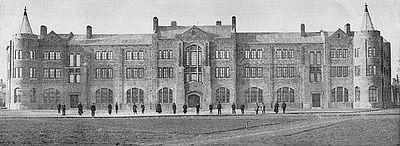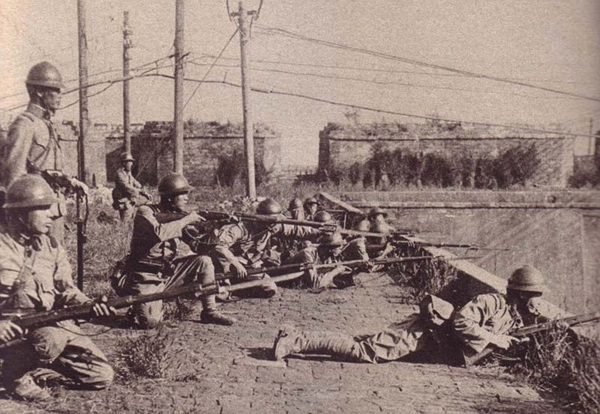|
Manchukuo
Manchukuo, officially known as the State of Manchuria prior to 1934 and the Empire of Great Manchuria thereafter, was a puppet state of the Empire of Japan in Northeast China that existed from 1932 until its dissolution in 1945. It was ostensibly founded as a republic, its territory consisting of the lands seized in the Japanese invasion of Manchuria; it was later declared to be a constitutional monarchy in 1934, though very little changed in the actual functioning of government. Manchukuo received limited diplomatic recognition, mostly from states aligned with the Axis powers, with its existence widely seen as illegitimate. The region now known as Manchuria had historically been the homeland of the Manchu people, though by the 20th century they had long since become a minority in the region, with Han Chinese constituting by far the largest ethnic group. The Manchu-led Qing dynasty, which had governed China since 17th century, was overthrown with the permanent abolition of the ... [...More Info...] [...Related Items...] OR: [Wikipedia] [Google] [Baidu] |
Soviet Invasion Of Manchuria
The Soviet invasion of Manchuria, formally known as the Manchurian Strategic Offensive Operation or simply the Manchurian Operation () and sometimes Operation August Storm, began on 9 August 1945 with the Soviet Union, Soviet invasion of the Empire of Japan's puppet state of Manchukuo, which was situated in Japanese-occupied Manchuria. It was the largest campaign of the 1945 Soviet–Japanese War, which resumed hostilities between the Union of Soviet Socialist Republics and the Empire of Japan after almost six years of peace. Soviet gains on the continent were Manchukuo, Mengjiang (the northeast section of present-day Inner Mongolia) and northern Korea. The Soviet entry into this theater of the war and the defeat of the Kwantung Army were significant factors in the Japanese government's decision to Surrender of Japan, surrender unconditionally, as it became apparent that the Soviet Union had no intention of acting as a third party in negotiating an end of the war on conditional ... [...More Info...] [...Related Items...] OR: [Wikipedia] [Google] [Baidu] |
Five Races Under One Union (Manchukuo)
Five Races Under One Union (, ) was used as a national motto in Manchukuo, for the five ethnic groups of the Manchus, the Japanese, the Han Chinese, the Mongols and the Koreans. It was similar to the " Five Races Under One Union" () motto used by the Republic of China, for the Han, Manchus, Hui, Mongols and Tibetans, but the third of the four Chinese characters was changed from Togetherness (共) to Cooperation (協). Both mottoes were pronounced the same "Go zoku kyōwa" in Japanese. This motto was symbolized in the national flag of Manchukuo, as the yellow base color (Manchus) with four striped colors in the upper left corner: red (Japanese), blue (Han Chinese), white (Mongols) and black (Koreans). Gallery File:Roundel of Manchukuo (1932–1945) – Manchukuo Air Transport Company.svg, Manchuria Aviation Company roundel, 1931–1945 File:War Ensign of Manchukuo.svg, War ensign of Manchukuo Manchukuo, officially known as the State of Manchuria prior to 1934 and the ... [...More Info...] [...Related Items...] OR: [Wikipedia] [Google] [Baidu] |
Changchun
Changchun is the capital and largest city of Jilin, Jilin Province, China, on the Songliao Plain. Changchun is administered as a , comprising seven districts, one county and three county-level cities. At the 2020 census of China, Changchun had a population of 9,066,906; its metro area, comprising five districts and one development area, had a population of 5,019,477. Shuangyang and Jiutai districts are not urbanized yet. It is one of the biggest cities in Northeast China, along with Shenyang, Dalian and Harbin. The name of the city means "long spring" in Chinese language, Chinese. Between 1932 and 1945, Changchun was renamed Xinjing ( zh, c=新京 , p=Xīnjīng, l=new capital) or Hsinking by the Kwantung Army as the capital of the Imperial Japanese puppet state of Manchukuo, occupying modern Northeast China. After the Proclamation of the founding of the People's Republic of China, foundation of the People's Republic of China in 1949, Changchun was established as the provincial ... [...More Info...] [...Related Items...] OR: [Wikipedia] [Google] [Baidu] |
Evacuation Of Manchukuo
The evacuation of the Japanese puppet state of Manchukuo occurred during the Soviet invasion of Manchuria in August 1945, part of the last phase of World War II. The Soviets recovered territory which had been captured by Japan during the Russo-Japanese War of 1904–1905, and they dismantled the Manchurian industrial infrastructure. This deprived Chiang Kai-shek's troops of a vital region of China, and gave Mao Zedong's Eighth Army the opportunity to establish bases in North East China. Kwantung Army strength On August 10, 1945, troops of the 17th Japanese Front (in Korea) and the Fifth Air Army were placed under the command of the Kwantung Army. At this point, the Japanese Kwantung Army numbered nearly 750,000 officers and men. It had 1,155 tanks and self-propelled guns, 1,800 warplanes, and 30 warships and gunboats. The entire Japanese force deployed in Manchuria, Inner Mongolia, and Korea numbered over one million officers and men. Soviet military operations in Manchuk ... [...More Info...] [...Related Items...] OR: [Wikipedia] [Google] [Baidu] |
Greater East Asia Co-Prosperity Sphere
The , also known as the GEACPS, was a Pan-Asianism, pan-Asian union that the Empire of Japan tried to establish. Initially, it covered Japan (including Korea under Japanese rule, annexed Korea), Manchukuo, and Wang Jingwei regime, China, but as the Pacific War progressed, it also included territories in Southeast Asia and parts of Azad Hind, India.William L. O'Neill, ''A Democracy at War: America's Fight at Home and Abroad in World War II''. Free Press, 1993, p. 53. The term was first coined by Minister for Foreign Affairs (Japan), Minister for Foreign Affairs Hachirō Arita on June 29, 1940. The proposed objectives of this union were to ensure Autarky, economic self-sufficiency and Economic union, cooperation among the member states, along with resisting the influence of Western imperialism in Asia, Western imperialism and Ideology of the Communist Party of the Soviet Union, Soviet communism. In reality, militarists and nationalists saw it as an effective propaganda tool to e ... [...More Info...] [...Related Items...] OR: [Wikipedia] [Google] [Baidu] |
Japanese Invasion Of Manchuria
The Empire of Japan's Kwantung Army invaded the Manchuria region of the Republic of China on 18 September 1931, immediately following the Mukden incident, a false flag event staged by Japanese military personnel as a pretext to invade. At the war's end in February 1932, the Japanese established the puppet state of Manchukuo. The occupation lasted until mid-August 1945, towards the end of the Second World War, in the face of an onslaught by the Soviet Union and Mongolia during the Manchurian Strategic Offensive Operation. With the invasion having attracted great international attention, the League of Nations produced the Lytton Commission (headed by British politician Victor Bulwer-Lytton) to evaluate the situation, with the organization delivering its findings in October 1932. Its findings and recommendations that the Japanese puppet state of Manchukuo not be recognized and the return of Manchuria to Chinese sovereignty prompted the Japanese government to withdraw from the L ... [...More Info...] [...Related Items...] OR: [Wikipedia] [Google] [Baidu] |
Imperial Seal Of Manchukuo
The Imperial Seal of the Emperor of Manchukuo () had a design of orchid ('' Cymbidium goeringii'') flower, with five ''sorghum'' branches in between the five orchid petals. It was entirely yellow. The design was based on ''Cymbidium goeringii'', the favorite flower of the Emperor of Manchukuo. ''Sorghum'' was the staple food of Manchukuo and was added as a part of the design. The imperial seal was adopted on 25 April 1934. . It also appeared on the Emperor of Manchukuo's personal standard. Gallery [...More Info...] [...Related Items...] OR: [Wikipedia] [Google] [Baidu] |
Battle Of Rehe
The Battle of Rehe (, sometimes called the Battle of Jehol) was the second part of Operation Nekka, a campaign by which the Empire of Japan successfully captured the Inner Mongolian province of Rehe from the Chinese warlord Zhang Xueliang and annexed it to the new state of Manchukuo. The battle was fought from February 21 to March 1, 1933. Background Following the establishment of Manchukuo, the Kwantung Army launched an operation to secure its southern frontier with China by attacking and capturing Shanhaiguan Pass at the Great Wall on 3 January 1933. The province of Rehe, on the northern side of the Great Wall, was the next target. Declaring the province to be historically a portion of Manchuria, the Japanese Army initially hoped to secure it through the defection of General Tang Yulin to the Manchukuo cause. When this failed, the military option was placed into action. Assigned to this operation were the Japanese 6th Division and 8th Division and 14th and 33rd Mixed Br ... [...More Info...] [...Related Items...] OR: [Wikipedia] [Google] [Baidu] |
Empire Of Japan
The Empire of Japan, also known as the Japanese Empire or Imperial Japan, was the Japanese nation state that existed from the Meiji Restoration on January 3, 1868, until the Constitution of Japan took effect on May 3, 1947. From Japan–Korea Treaty of 1910, 1910 to Japanese Instrument of Surrender, 1945, it included the Japanese archipelago, the Kuril Islands, Kurils, Karafuto Prefecture, Karafuto, Korea under Japanese rule, Korea, and Taiwan under Japanese rule, Taiwan. The South Seas Mandate and Foreign concessions in China#List of concessions, concessions such as the Kwantung Leased Territory were ''de jure'' not internal parts of the empire but dependent territories. In the closing stages of World War II, with Japan defeated alongside the rest of the Axis powers, the Japanese Instrument of Surrender, formalized surrender was issued on September 2, 1945, in compliance with the Potsdam Declaration of the Allies of World War II, Allies, and the empire's territory subsequent ... [...More Info...] [...Related Items...] OR: [Wikipedia] [Google] [Baidu] |





